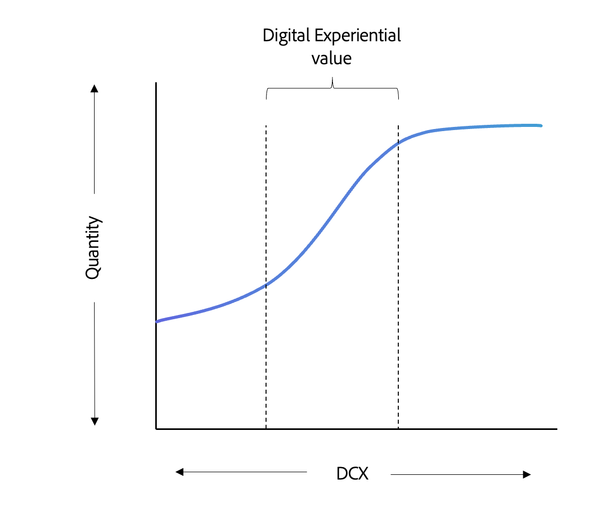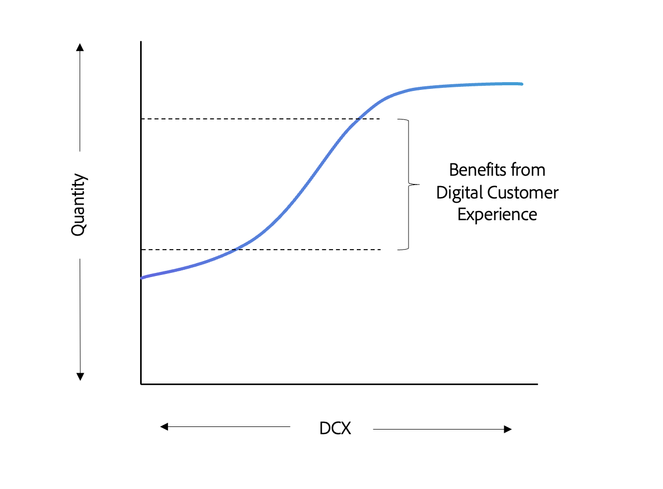You can download the PDF file of this article here
Many organisations begin their efforts to optimise the Digital Customer Experience with a broad aspiration. Senior leadership launches different initiatives to delight customers with innovations and disruptive moves. But often organisations fail to link Digital Customer Experience with Business Economics outcomes and thus having costs and unclear near-term results. In my paper you can read more about how to link Digital Customer Experiences with Business Economics and why I argue that Digital Customer Experiences are elastic in nature.
Delivering Digital Customer Experience invariably raise questions about business economics, priorities, and how to invest in it. Without a quantified link to value such efforts often can’t show clear gains and as such clear foundation to create momentum in your organisation.
But value is dual concept. We can distinguish customer- and organisational value. Clearly, for both the customer and the organisation, it is paramount to receive and create as much value as possible.
As Blois (2003) explained, even if a definition of customer value can be agreed, it is unclear as to exactly what form of value an organisation should pursue. It does not matter to an organisation how the customer interprets value, as long as the organisation has an understanding of what that interpretation is. It is a vital item of information that an organisation needs about its customers and is not just the core need that the product or service being offered will fulfil but in addition how the customer perceives the purchase contributing to its generation of value. It is the customer's perception of how the purchase of a product or service contributes to the achievement of its fundamental objectives that is important. An organisation must develop product offerings that add value to the customer in the customer's terms.
Customer Value
How you define value is interesting. It changes from customer to customer and from product to product (or service). According to Burns and Woodruff (1992) customer value is:
“Customer value is the customer perceived benefit adjusted with the relative sacrifice.”
In addition to this, Burns (1993) explained that customer value is something perceived by customer rather than objectively determined by the seller. These perceptions involve a trade-off between what the customer receives in benefits (quality, worth, utilities) and what the customer sacrifices (price, give up to acquire). Different scholars have been classifying customer Value. Some provides categories within which to group types of value, like functional, social, emotional etc. Other classifications go one step further by specifying relationships between value types. For instance, product value, product in use, possession value etc.
In this series of articles, I’ll combine the different classifications and put them in the context of Digital Customer Experiences.
Linking Customer Value with Digital Customer Experiences
In my previous paper, I introduced the concept of Digital Customer Experience Elasticity. A measurement of the degree of change in demand and/or price in response to a change in Digital Customer Experience. In my paper I argued that the impact of Digital Customer Experiences on demand is a mathematical function, a S curve sigmoid function because when the customer values the experience with an organisation beyond his/her expectation, the demand will increase. But the slope flattens when the degree of Digital Customer Experiences is more than the customer expects or values.
In this article, I introduce a new concept where I link Digital Customer Experiences with Customer Value. Using the Digital Customer Experience Elasticity curve as pictured in the figure below, I note that the uplift is attributable to Digital Experiential Value.

Digital Experiential Value - uplift of quantity with Digital Customer Experiences
Digital Experiential value can be defined as the customer’s perception, which stems directly or indirectly from his or her digital experience of the product/service. Digital Experiential Value is distinct from the product/service value because it is a result of the Digital Customer Experience. It focuses on customers’ subjective emotions and reactions because it varies according to the type of digital experience.
“Digital Experiential value perceptions arebased upon digital interactions involving either direct usage or distanced appreciation of goods and services.”
To give an example of Digital Experiential Value, imagine when you open a bank account to transfer money to your kid, when using your mobile phone, the different steps to open an account are easy, without any hassle, you will get personal assistance during the different steps. It feels literally that you are interacting with a human who understands what you need and how you want to be guided and/or delighted.
The value in exchange is the way we conventionally talk about value creation. Common sense tells us that value is created by organisations in the products and services they provide, and this is then distributed and sold to customers.
In one of the next articles, I’ll dive deeper in the phenomena of value since there is a distinction to made, as Woodruff and Gardial (1996) explained. What is the desired Digital Experiential Value when customers consider buying a product, or what are the desired consequence when using the product/service etc.
Organisational value of Digital Customer Experience
Organisations/suppliers and customers are two separate entities in a supply chain. A financial company puts value into its products by providing financial products and services that benefit the customer. This product is then exchanged for sacrifice, often money.
This money is captured by the organisation and is the benefit of the value transfer from the product/service to the customer.
When putting this in the context of Digital Customer Experiences, I argue that the Digital Customers Experiences uplift the organisational value and as such the benefits of the organisation. To illustrate this, I use the Digital Customer Experience Elasticity curve and logical argumentation to define the benefits of Digital Customer Experiences. (Figure 2)

Benefits of Digital Customer Experiences for supplier/organization
Future perspectives
In the next article I will dive deeper in how Digital Customer Experiences have impact on both customer and organisational value. I’ll use different value models to explain how a change in Digital Customer Experience will change the balance between benefits and sacrifices. Subscribe to my newsletter to get notified once my next article is available.
References
Blois, K. (2003). Using value equations to analyse exchanges. Marketing Intelligence & Planning, 21(1), 16-22.
Doyle, P. (2000), Value-based market strategies, Journal of Brand Management, Vol. 7 No. 5, pp. 317-19.
Woodruff, R. B., & Gardial, S. (1996). Know your customer: New approaches to understanding customer value and satisfaction. Wiley.
https://hbr.org/1998/11/business-marketing-understand-what-customers-value
Digital Customer Experience Elasticity explaind
In this article I introduce the concept of Digital Customer Experience Elasticity. A concept that explains how Digital Customer Experiences influences the quantitiy demanded of a customer using logical argumentation.
Impact of Digital Customer Experiences on industries
In this article I argue that the impact of Digital Customer Experience has a significant cushioning effect on demand when a sector is at risk. When a sector or industry is at growth, the impact of Digital Customer Experiences is positive but less significant compared to when a sector is at risk
Conclusion Paper Digital Customer Experience Elasticity
Download here the full paper of the three articles on Digital Customer Experience Elasticity